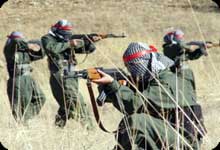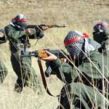
PJAK Faces Turkish-Iranian Storm
Publication: Terrorism Monitor Volume: 5 Issue: 21
By:

The last year has seen steadily increasing violence between Turkey and the Kurdish Workers’ Party (PKK). On October 21, 2007 a group of PKK fighters killed 12 Turkish soldiers and captured eight others in an attack in southeastern Turkey. Since then Turkey has called on the United States, the Kurdish Regional Government and Iraq’s government in Baghdad to take actions against the 3,000 PKK members based in Iraqi Kurdistan. Simultaneously Turkey has built up its military forces on Iraq’s border in apparent preparation for an incursion into northern Iraq to root out the PKK militants based there and to destroy related camps and training facilities.
Analysis of this increasingly tense stand-off has largely focused on how U.S.-Turkish relations will be affected and how the leaders of Iraqi Kurdistan will react to Turkey’s increasingly shrill ultimatums. Overlooked in this complex equation is the role that the estimated 1,500 members of the PKK’s Iranian sister organization, the Party for a Free Life in Kurdistan (PJAK), will play in any conflict.
In order to understand PJAK’s attitude towards Iraqi Kurds, Turkey, Iran and the PKK—as well as the group’s likely response to any moves against the PKK—it is necessary to appreciate the group’s origins. PJAK was founded as a civil society movement in Iran in the late 1990s, partly inspired by the PKK, to promote Kurdish nationalism among Iran’s roughly 5 million-strong Kurdish minority. Within a few years, however, the group’s increasing success and its sporadic acts of violence against Iran’s security service provoked a government crackdown. This forced its leadership to move to Iraqi Kurdistan where the group began to work closely with the PKK, basing itself in the PKK’s main camp on the sides of Mount Qandil on the border between Iraq and Iran. Following this move, the group became increasingly militant, discarding much of its student activism and receiving military training and logistical assistance from the PKK.
Since 2004, PJAK has profited from access to the PKK’s military and organizational expertise. The group’s attacks on the Iranian military have become increasingly effective, killing around 100 Iranian troops and security forces a year since 2005. At the same time, however, PJAK’s comparatively youthful leadership has made the group relatively immune to the lethargy, indecision and in-fighting that has on occasion plagued the PKK. Compared to the PKK, which was involved in an intermittent conflict with Iraqi Kurds through much of the early and late 1990s, PJAK’s relationship with Iraq’s Kurds has been less tense. At the same time, however, PJAK leadership remains heavily indebted to the PKK—not only because the group relies on the PKK’s logistical apparatus and battle experience but also because substantial numbers of the PJAK’s older members had been in the PKK before PJAK’s formation in the late 1990s. Despite this, however, PJAK has repeatedly attempted to distance itself from the PKK when reaching out to Western governments in the hope of receiving military or economic aid to help it fight against the Iranian government.
Growing strength but uncertain future
Consequently PJAK is in a strong position. The last few years’ uneasy equilibrium in Iraqi Kurdistan have allowed it to remain on good terms with Iraq’s Kurds and the PKK while also continuing to carry out attacks in Iran and bidding, both covertly and overtly, for Western support. These strong foundations—and a solid recruiting base in Iran—should allow PJAK to face the storm gathering on the borders of Iraqi Kurdistan with some confidence.
In military terms, 2007 has been PJAK’s most successful year so far. Although the PKK’s attacks against Turkish targets achieve much greater coverage, PJAK’s activities in Iran appear often to be of only a marginally smaller size and scope. On September 1, 2007, a press release purportedly issued by the group claimed that PJAK had killed 113 Iranian troops this year and destroyed six vehicles [1]. In addition the group has possibly begun to access more advanced weaponry. For example in February, PJAK members shot down a helicopter belonging to Iran’s Islamic Revolutionary Guards Corps (IRGC) near the town of Khoy in southwestern Iran, although it remains unclear whether the aircraft was brought down by rocket or small-arms fire (Today’s Zaman, August 20). Fars, the Iranian state news agency, reported that a senior IRGC commander, Saeed Ghahari, was killed in the crash (Al Jazeera, February 24).
Comparing the relative strengths of the PKK and PJAK is fraught with difficulties, however. The Iranian military is less organized and modern than the Turkish army and therefore presents an easier target. Critically, Iranian forces are less able to mount the swift counterattacks that the Turkish army has used to great success following PKK raids. In particular the Iranian forces are hampered by a lack of helicopters—although the Iranian military does have around 40 modified Cobra attack helicopters purchased from the United States before 1979. Balanced against this, however, is that Kurds in Iran make up less than 10 percent of the total population compared to over 20 percent in Turkey. As a result, PJAK has not only a smaller absolute pool of potential recruits than the PKK but also operates in a relatively less sympathetic milieu.
There is reason to believe that—not counting a Turkish invasion of Iraq—PJAK will become a greater irritant to the Iranian forces in southwestern Iran. For example, in the last year the PKK has begun making extensive use of IEDs in Turkey (Terrorism Focus, June 26). As yet there is no evidence that this technology has been transferred to PJAK. Given the close links between the two groups, however, the use of similar IEDs by PJAK over the coming months is probably all but inevitable. In Turkey such IEDs have already inflicted considerable damage—against less modern Iranian equipment their effect would be multiplied.
Since mid-2006, PJAK has also shown a growing awareness of the importance of a media strategy for building local and international support, even granting interviews to Western media outlets such as the New York Times [2]. Between the late 1990s and early 2006, in comparison, the group did not carry out a single interview with the Western press, although this change may reflect the group’s increasing profile outside Kurdistan. In addition, the group has begun filming attacks and their aftermath in the manner of other Middle Eastern insurgent groups. According to Fars, some members of PJAK have even been arrested for filming the funerals of Iranians soldiers killed by these attacks (Fars, March 4); other videos have appeared on YouTube. Some of these take the form of formal press conferences, others commemorate PJAK’s “martyrs,” others again are more overt recruitment videos with pro-independence Kurdish songs, including Kurdish rap played over footage of young PJAK members training in the Qandil Mountains. Some of the media productions emphasize the group’s ideological debt to Abdullah Öcalan, the jailed leader of the PKK, while others do not, perhaps suggestive of the group’s own uncertainty over their relations with the PKK. All the group’s videos emphasize the prominent role of women in the group and their equality with male fighters. This presentation aims to contrast PJAK’s attitude to women against the policies of the Iranian government, which many Kurds regard as an assault on their relatively liberal traditions.
Prospects
Any Turkish military action will be closely coordinated with Iran, which regularly shells PKK and PJAK bases in the Qandil mountain range from its military bases four miles away on the nearby Iraqi-Iranian border (PUKmedia, October 25). Turkey and Iran already have long-standing agreements to cooperate against Kurdish militants. As early as July 2004, for instance, Turkish Prime Minister Recep Tayyip Erdoğan visited Tehran to develop a joint strategy against Kurdish militants (Iran Press Service, July 28, 2004). Iran regularly hands over captured Turkish Kurds to Turkey. Ankara in return delivers Iranian Kurdish insurgents to the Iranian military where they face torture and execution. For example, in early 2006 Iran sent 30 suspected PKK members to Turkey (The New Anatolian, February 25, 2006). In any military assault on the Qandil Mountains, Iranian forces would probably aim to block PKK attempts to flee into Iranian Kurdistan and perhaps even enter Iraqi Kurdistan to attack PJAK bases in the confusion caused by a Turkish assault.
In the event of such an invasion, much would hinge on whether Iraqi Kurds resisted or stood by. If they were to resist, PKK and PJAK members would almost certainly disregard past differences with the Iraqi-Kurdish leadership and join them. If Iraqi Kurds stood aside, however, PKK and PJAK forces would have to choose between making a last stand or attempting to blend into the local population and escape. In either case, the two Kurdish groups would probably feel honor-bound to help each other. They would also seek to rally local people to their side and would probably use force against anyone who did not cooperate. Providing PKK/PJAK did not alienate ordinary Kurds (as they did spectacularly in the 1990s in both Iraq and Turkey), they would likely receive a high degree of tacit and open support from Iraqi Kurds, including members of the security forces.
If, as seems most likely, Turkey puts economic pressure on the Iraqi Kurds to force them to either arrest PKK leaders or prevent future PKK operations, PJAK would have time to relocate itself away from the Qandil region and to re-distribute its forces around Kurdistan in a way that the PKK would be unable to do. This would disrupt PJAK’s training and operations but would allow the group to survive in the long-term relatively unscathed. Even in the event of a massive Iranian-Turkish-U.S. strike on its PKK-linked bases, PJAK would still survive. It has well-developed recruiting and an infrastructure already in place in Iran and a funding network in Europe (particularly in Germany). There is no doubt PJAK would use the heightened profile created by such an attack to attract new recruits and funding from Kurds in Iran and elsewhere.
Notes
1. The press release may not be authentic. It can be accessed at https://www.cl-netz.de/read.php?id=22422
2. The article can be accessed at https://www.nytimes.com/2007/10/23/world/middleeast/23kurds.html




